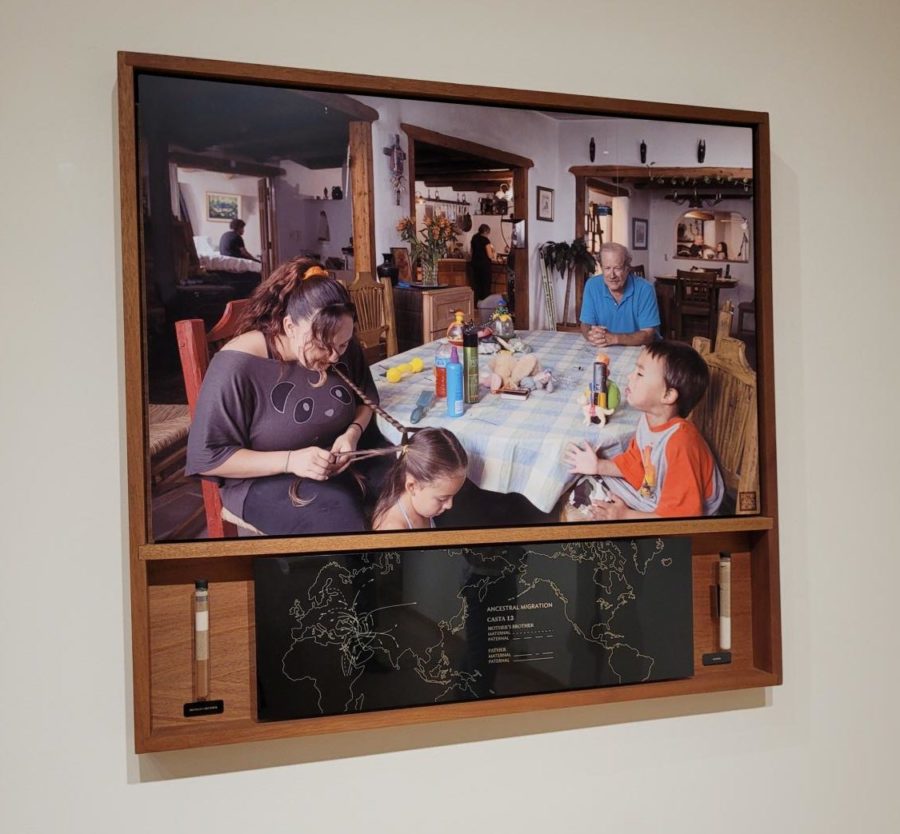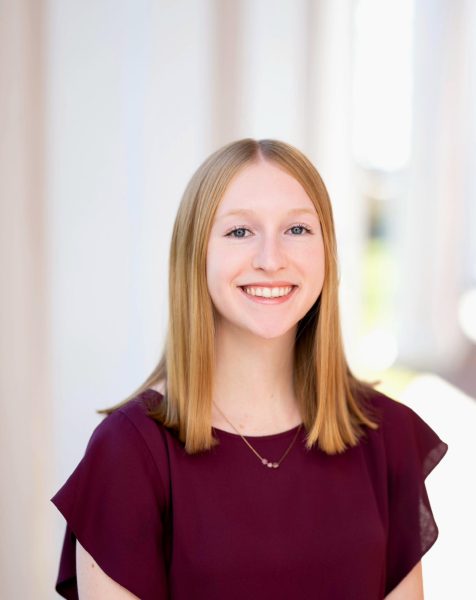New art exhibits illuminate underrepresented narratives
The collections fill gaps in W&L representation of Arab American and Chicana artists
Delilah Montoya’s art responds to casta portraiture by centering the vivid lives and uniqueness of each family. Photo by Emma Malinak, ’25
May 8, 2023
Washington and Lee unveiled two new art exhibits in April. The installations bring unique points-of-view to the university’s art collection, with five Arab American artists’ work featured in Leyburn Library and Chicana artist Delilah Montoya’s work showcased in the Staniar Gallery.
Art history professor Andrea Lepage said the kinds of artwork recently introduced to campus are helpful for students to become more globally minded and understanding of others’ experiences.
“We at W&L pride ourselves in telling students about different perspectives and different narratives and diverse viewpoints,” she said. “I think that artwork has a way of expressing that, in ways that written word or spoken word cannot. You can stand in front of one of those artworks and connect in a way that could be unexpected, but could touch you pretty profoundly.”
Isra El-beshir, director of the Museums at Washington and Lee, curated the “We Love Life Whenever We Can” exhibit, bringing the work of five Arab American artists together into one cohesive, immersive display.
El-beshir said the idea for the exhibit came from faculty members. Professors who teach Arabic or specialize in Middle-Eastern politics, religion, history and economics wanted to have artwork on campus that represented those topics, because they are often underrepresented in the artistic sphere. El-beshir said she knew this exhibit would also allow students to develop an empathy toward Arab Americans’ experiences.
“It can be an opportunity where you introspect,” she said. “You can use it as a time to reflect, think about your own place in society, or try to understand what someone else’s life is like.”
The exhibit opened on April 1 to celebrate National Arab American Heritage month and will remain on display on the first floor of Leyburn Library until December. El-beshir said an exhibit of this level of importance demanded her and her colleagues to “work beyond our walls” and place the artwork in an area that receives high traffic from students and professors.
“It brings in an audience that we otherwise won’t see in the museums,” she said. “It’s to showcase that we have a museum that cares about the arts and wants to engage you.”
The artwork is on loan from the Arab American National Museum, a Smithsonian affiliate and the only museum of its kind devoted to documenting and preserving the history of Arab Americans.
El-beshir began her career at the Arab American National Museum, and said she applauds the work it does to combat the Islamophobia that has grown since 9/11 and “tell the proper story and continue celebrating the culture mosaic of the U.S.”
While the museums at Washington and Lee have over fifteen thousand items in their collection, El-beshir said the loan was necessary because few artworks created by minority artists are featured. With this lack of representation in mind, El-beshir said she was careful to loan artwork that depicted a diverse array of experiences of Arab Americans.
The result of El-beshir’s selection is an exhibit that features the artwork of Mary Tuma, John Halaka, Youmna Chlala, Sama Alshaibi and Dena Al-Adeeb. As a whole, the collection displays the agony of contemporary conditions of exile, migration and conflict. It explores the themes of exclusion and identity of Arab Americans. It has a unique focus on the intersection between scholarship and art.
The artwork ranges from a large canvas painting to photographs to videos on mounted screens. El-Beshir said the artist that she finds the most interesting is Alshaibi, a woman who she says is in “deep dialogue with post-colonialism” and balances scholarship with creativity.
On the other side of campus in the Staniar Gallery, another exhibit is exploring how art can navigate the social issues and culture of a post-colonial world. This gallery is showcasing the work of Delilah Montoya in an exhibit titled “Contemporary Casta Portraiture,” which opened on April 24 and will remain open until May 25.
Montoya’s work can be found in prestigious collections across the country, including the Smithsonian American Art Museum, New Mexico Museum of Art, and The Bronx Museum of the Arts. She gave a public talk in Wilson Concert Hall on April 26 to introduce her work to the Lexington community.
Montoya refers to her work as “decolonial art.” When she creates, Montoya said, she always asks herself how she can bring agency back to people whose lives were changed by colonialism.
The show in Staniar Gallery responds to a specific practice of colonialism called “casta painting,” which was an artistic style that cemented racist social statuses in Mexico.
“The racial hierarchies and class structures that the original castas alluded to still exist today,” Montoya said. “My desire was to investigate colonialism as a place where racial classifications were established and demonstrate how those colonial truths still govern how we negotiate and understand our social structure.”
The tradition of casta painting was only practiced in 18th-century colonial Mexico, which consisted of modern-day Mexico along with areas of the south-western United States. Montoya said this practice may have developed at this time and place in history because there was a “fascination with hybridity”—meaning that Spaniards, Indigenous people, and enslaved African people were having children with each other—and how that hybridity needed to be translated into a social hierarchy to maintain order.
Each casta consisted of 16 images in what Montoya calls a “formulaic” order of racial classifications.
The first painting, always of a Spanish man, an elite Indigenous woman and their child, represented a family at the top of the social hierarchy.
The subsequent paintings were organized in a numerical scale that indicated that the less European children were, the lower on the social hierarchy they belonged.
Each image within a casta series included a triad of mother, father and child to establish this lineage. The clothing, settings and occupations of the subjects signaled their economic and class divisions.
Each image bore racial labels as titles, like “mestizo” (a person of Indigenous and European descent) and “mulatto” (a multiracial person of African descent). Montoya said these terms still exist in derogatory racial terminology today.
As Montoya studied these 200-year-old paintings, she was most disturbed by the fact that the subjects of the paintings were reduced to who their parents were and what the color of their skin was. She decided to make a new type of casta, one that showed the diversity, personality and beauty of modern families in New Mexico and Texas.
“The contemporary casta families were provided agency to represent their own stories,” Montoya said. “Rather than a representation of a constructed identity to fit a description based on the colonial gaze, as the regional casta paintings did, the contemporary families were asked to represent themselves.”
Montoya made three key changes to the casta tradition in her own work.
First, she took photographs of the families rather than painting them. She said this allowed each family to have control over the setting, and allowed her to capture candid, intimate moments. Each image has a QR code as well, which allows audiences to hear the subjects’ voices and learn about their home and family in their own words.
Montoya also discarded the traditional labeling system of the casta paintings. She created her own titling system by using DNA testing to track the numerous parts of the world where each subject’s descendants called home. Instead of using arbitrary labels like “mulatto,” Montoya included a full map under each casta image that pinpoints where each family comes from.
Montoya also eliminated the hierarchical numbering system. She randomized the order that the images are displayed, reinforcing the idea that no family deserves more social privileges or respect than another.
Montoya said the love within each family inspired her. The work she did proved that mestizaje, a word for the ethnic mixings that occurred in colonial Mexico, should never be reduced to biased numbers and labels.
“What I learned from this series is that there is not a formula to mestizaje,” she said.
Students in Lepage’s spring term class, called Chicana/o Art and Muralism, met Montoya to learn more about her work. Julie Ham, ’25, said meeting Montoya was inspiring, especially after hearing about the dark history of casta portraiture.
“Those symbols automatically erase a lot of voices,” she said. “The exhibit definitely helps repair some of that damage.”
Clover Archer, director of the Staniar Gallery, said an exhibit like this can help students to get a fuller picture of what they have already learned in history classes or in their own observations of modern examples of racism.
“I think that this work is incredibly important because it reaches outside of the art department,” she said. “It’s exciting for our students, as liberal arts students, to see how art does that, how it reaches outside of the art gallery.”




